Overview
On the modern web, trackers and advertisers frequently construct and monetize users’ detailed behavioral profiles without consent. Despite various studies on web tracking mechanisms and advertisements, there has been no rigorous study focusing on websites targeted at children. To address this gap, we present a measurement of tracking and (targeted) advertising on websites directed at children. The findings reveal that approximately 90% of these websites employ trackers and 27% display targeted advertisements without adequate parental consent. The study also exposes the presence of inappropriate ads, emphasizing a widespread non-compliance with privacy regulations and the urgent need for more stringent protective measures for children online.
Findings
🚫 Improper Ads on Children's Websites
In our study, we identified and measured four types of ads: weight loss ads, mental health ads, dating services ads, and ads containing clickbait racy content. Figure 1 illustrates the ad content analysis pipeline. To detect ads with clickbait racy content, we utilized Google Cloud Vision API’s SafeSearch Detection. Additionally, we used semantic similarity to identify the most relevant ad texts for the queries "weight loss," "mental health," and "dating." Table 1 shows the number of improper ads identified in each crawl, amounting to 1,003 across 311 distinct websites. A notable finding is the higher prevalence of such ads on mobile devices compared to desktops in general.
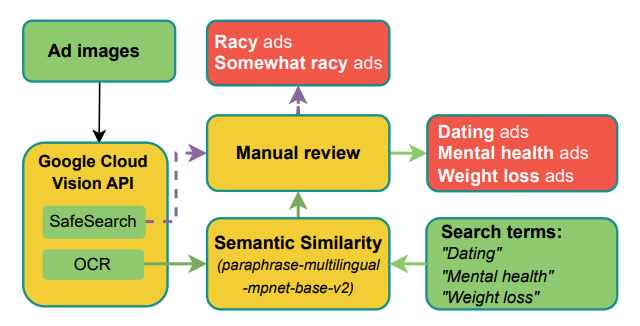
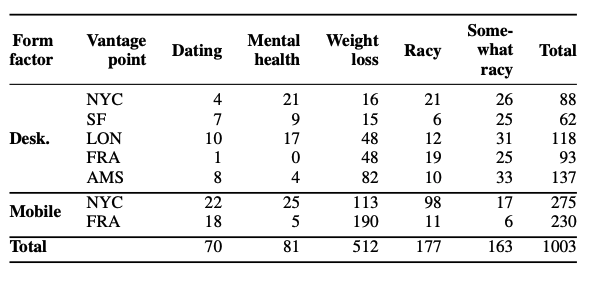
In Figure 2, we provide additional examples of advertisements that are likely not suitable for children. Examples of these included an ad for a test called “Am I Gay Test” ⓓ , for a sex toy ⓘ and a sex toy shop ⓑ featuring an image of ice cream that could be appealing to children, and ads featuring clickbait and sexually suggestive images. The ads were found on websites related to K-12 e-learning, kids games, coloring books and worksheets, among others.
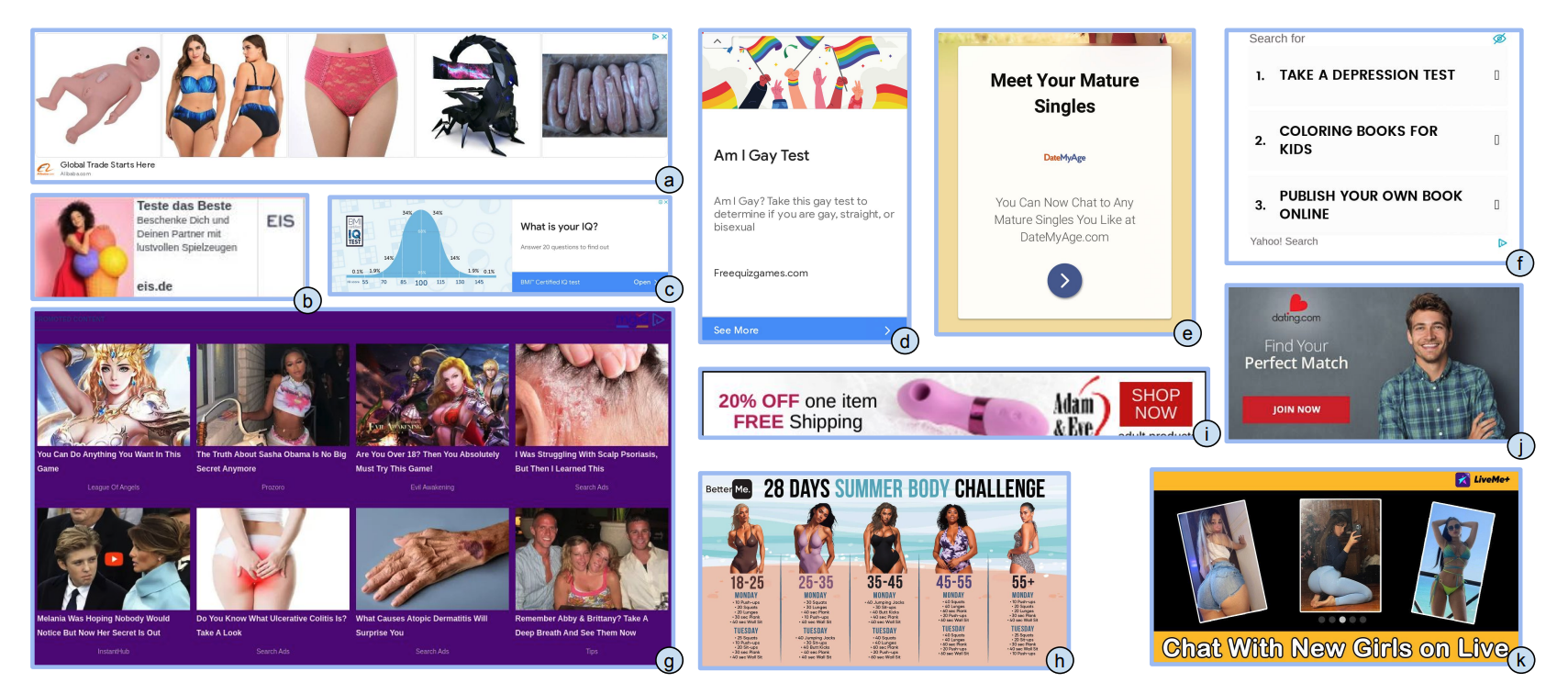
Targeted Ads on Children's Websites
Over 70% of ads with disclosures are targeted in
nature. Our crawler captured a total of 40,281 ad disclosure
pages, which we used to determine the advertiser’s identity
and whether ad targeting is enabled or not. There are fewer
disclosure pages than ads due to ads without disclosure links
and failures in detecting or opening those links. In fact, we
only consider ad disclosures from two ad providers: Google
(97.8%) and Criteo (2.2%), since ad disclosure pages of
other providers did not reveal the targeted status of the ad or the advertisers’ identity. In Table 2, we show the the results of our analysis of ad disclosures.
Comparing the Tranco ranks of the 689 websites that contain
at least one targeted ad to 59 websites that only contain
non-targeted ads, we find a tendency for popular websites
to disable ad targeting (Figure 2). Sites with targeted ads
had a median rank of ∼ 340K, while those with only nontargeted ads had a median rank of ∼ 128K.
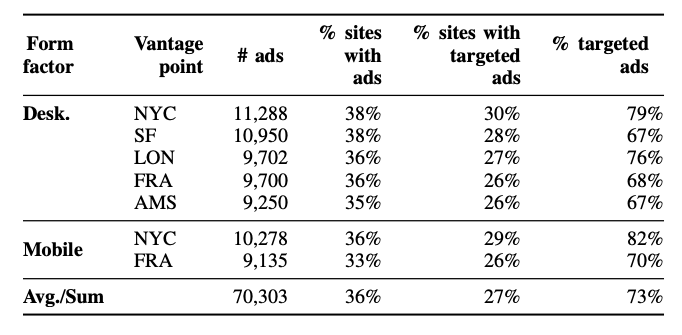
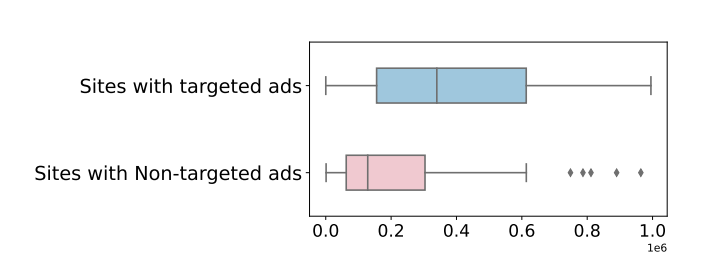
Tracking and fingerprinting analysis
We also conducted a comprehensive analysis of tracking and fingerprinting on children's websites.
Table 3 shows the average number of third-party and tracker domains, and the prevalence of tracking and fingerprinting on
child-directed websites from five vantage points.
We also conducted an additional analysis to compare how the
number of third parties and trackers change between websites with and without ads. Figure 4 shows that websites with
ads tend to have substantially more third-party and tracker
domains.
Table 4 shows the top five websites with the most trackers in the Frankfurt and NYC crawls. These websites, likely receiving significant traffic as they are among the top one million, all displayed targeted ads. The numbers in the table reflect average trackers, requests, and cookies across web pages.
Disclosures and outreach
- We contacted 5 companies serving racy ads: One explained the issue as mislabeling and pledged further investigation. Another thanked us and began an internal review, while a third redirected our query to the relevant department.
- Reported racy ads to Google
- Shared our results with European data protection agencies and a consumer protection agency
- Shared our findings with civil society and industry organizations including the 5Rights Foundation
Contact
| Zahra Moti | ✉️ zahra.moti@ru.nl |
| Gunes Acar | ✉️ g.acar@cs.ru.nl
|
| Asuman Senol | ✉️ asuman.senol@esat.kuleuven.be |
| Hamid Bostani | ✉️ hamid.bostani@ru.nl |
| Frederik Zuiderveen Borgesius | ✉️ frederikzb@cs.ru.nl |
| Veelasha Moonsamy | ✉️ veelasha.moonsamy@ruhr-uni-bochum.de |
| Arunesh Mathur | ✉️ aruneshmathur1990@gmail.com |